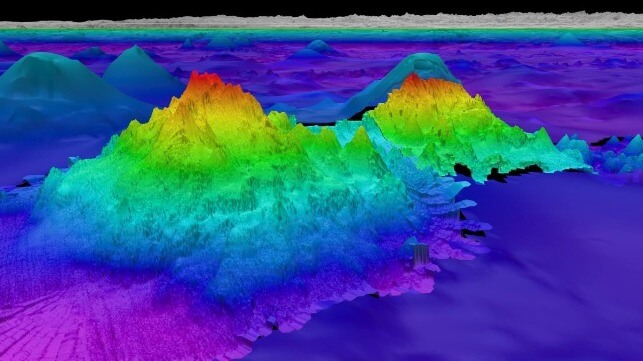Independent Researchers Reveal Four Unknown Seamounts

Scientists aboard the Schmidt Ocean Institute’s (SOI) research vessel Falkor (too) have discovered four underwater mountains off the west coast of South and Central America, a development that advances the understanding of the vast water bodies.
SOI said that while the vessel was on transit from Golfito, Costa Rica, to Valparaiso, Chile, the crew discovered new seamounts that range in size from about 1,591 meters to 2,681 meters. The largest is 2,681 meters tall, covers 450 square kilometers and sits 1,150 meters below the surface.
The institute highlighted the latest discovery of the seamounts by Falkor (too) is the latest in a series. In November last year, the vessel’s crew discovered an underwater mountain that was twice the height of the Burj Khalifa (1,600 meters) in international waters off Guatemala.
Since 2012, SOI scientists have mapped about 1.5 million square kilometers of ocean floor and discovered 29 seamounts, hills and trenches. The underwater mountains and trenches often host deep-sea coral reefs, sponges and anemones living alongside organisms that find food, shelter and a rocky surface to cling to along mountain slopes.
Dive 646. Usually when you see a coral, you see an ophiuroid. Plexaurid (?) with an oph, metalligorgia with an oph, and a Callogorgia and an oph. JF6 Seamount off coast of Chile @SchmidtOcean #SEPacificSeamounts pic.twitter.com/hSEbjUxdjR
— Veronica - LeapinLemurs83 (@leapinlemurs83) February 12, 2024
The research vessel Falkor (too) has been instrumental in the discoveries. Built in 2011 as the offshore industry vessel Polar Queen, SOI acquired the ship from Norwegian shipping company GC Rieber Shipping ASA.
The 110 meter vessel was refitted to become a state-of-the-art mobile research facility with modern laboratories, tools, equipment, and high-performance computing system that offers scientists and innovators an opportunity to expand their ability to explore and study the ocean. The vessel replaced Falkor, which SOI donated to Italy’s science agency National Research Council (CNR), in 2022.
In the latest discoveries, SOI marine technicians and hydrographic experts used multibeam mapping to confirm that the seafloor features had not been previously included in any bathymetric database.
The seamounts were found as the team plotted a course to examine gravity anomalies during the transit from Costa Rica to Chile. Changes in the shape of the seafloor appear as very slight shifts in the ocean surface; a deep trench will cause a slight depression and a mountain can create an almost imperceptible bump on top of the ocean. These subtle clues can help experts make discoveries and create better more detailed maps of the seafloor.
“A map is a fundamental tool for understanding our planet — locating seamounts almost always leads us to understudied biodiversity hotspots. Every time we find these bustling seafloor communities, we make incredible new discoveries and advance our knowledge of life on Earth,” said Dr. Jyotika Virmani, SOI Executive Director.
